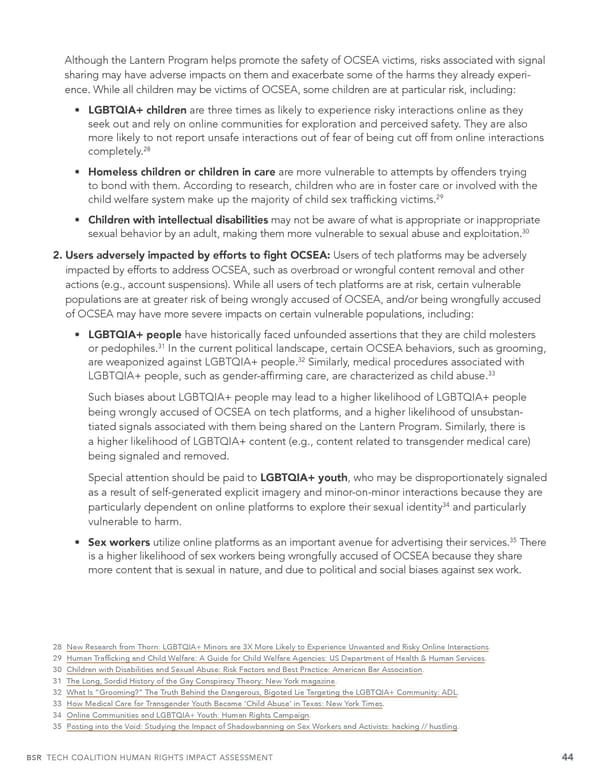Although the Lantern Program helps promote the safety of OCSEA victims, risks associated with signal sharing may have adverse impacts on them and exacerbate some of the harms they already experi- ence. While all children may be victims of OCSEA, some children are at particular risk, including: • LGBTQIA+ children are three times as likely to experience risky interactions online as they seek out and rely on online communities for exploration and perceived safety. They are also more likely to not report unsafe interactions out of fear of being cut off from online interactions 28 completely. • Homeless children or children in care are more vulnerable to attempts by offenders trying to bond with them. According to research, children who are in foster care or involved with the 29 child welfare system make up the majority of child sex traf昀椀cking victims. • Children with intellectual disabilities may not be aware of what is appropriate or inappropriate 30 sexual behavior by an adult, making them more vulnerable to sexual abuse and exploitation. 2. Users adversely impacted by efforts to 昀椀ght OCSEA: Users of tech platforms may be adversely impacted by efforts to address OCSEA, such as overbroad or wrongful content removal and other actions (e.g., account suspensions). While all users of tech platforms are at risk, certain vulnerable populations are at greater risk of being wrongly accused of OCSEA, and/or being wrongfully accused of OCSEA may have more severe impacts on certain vulnerable populations, including: • LGBTQIA+ people have historically faced unfounded assertions that they are child molesters 31 In the current political landscape, certain OCSEA behaviors, such as grooming, or pedophiles. 32 are weaponized against LGBTQIA+ people. Similarly, medical procedures associated with 33 LGBTQIA+ people, such as gender-af昀椀rming care, are characterized as child abuse. Such biases about LGBTQIA+ people may lead to a higher likelihood of LGBTQIA+ people being wrongly accused of OCSEA on tech platforms, and a higher likelihood of unsubstan- tiated signals associated with them being shared on the Lantern Program. Similarly, there is a higher likelihood of LGBTQIA+ content (e.g., content related to transgender medical care) being signaled and removed. Special attention should be paid to LGBTQIA+ youth, who may be disproportionately signaled as a result of self-generated explicit imagery and minor-on-minor interactions because they are 34 and particularly particularly dependent on online platforms to explore their sexual identity vulnerable to harm. 35 • Sex workers utilize online platforms as an important avenue for advertising their services. There is a higher likelihood of sex workers being wrongfully accused of OCSEA because they share more content that is sexual in nature, and due to political and social biases against sex work. 28 New Research from Thorn: LGBTQIA+ Minors are 3X More Likely to Experience Unwanted and Risky Online Interactions. 29 Human Traf昀椀cking and Child Welfare: A Guide for Child Welfare Agencies: US Department of Health & Human Services. 30 Children with Disabilities and Sexual Abuse: Risk Factors and Best Practice: American Bar Association. 31 The Long, Sordid History of the Gay Conspiracy Theory: New York magazine. 32 What Is “Grooming?” The Truth Behind the Dangerous, Bigoted Lie Targeting the LGBTQIA+ Community: ADL. 33 How Medical Care for Transgender Youth Became ‘Child Abuse’ in Texas: New York Times. 34 Online Communities and LGBTQIA+ Youth: Human Rights Campaign. 35 Posting into the Void: Studying the Impact of Shadowbanning on Sex Workers and Activists: hacking // hustling. BSR TECH COALITION HUMAN RIGHTS IMPACT ASSESSMENT 44
 Tech Coalition Human Rights Impact Assessment of the Lantern Program Page 43 Page 45
Tech Coalition Human Rights Impact Assessment of the Lantern Program Page 43 Page 45